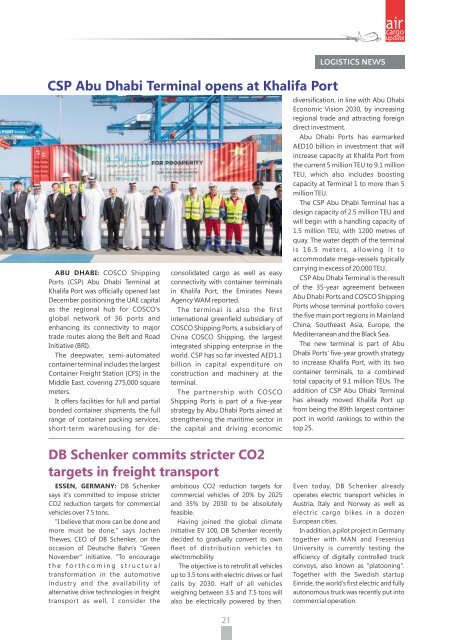Create successful ePaper yourself
Turn your PDF publications into a flip-book with our unique Google optimized e-Paper software.
CSP Abu Dhabi Terminal opens at Khalifa Port<br />
ABU DHABI: COSCO Shipping<br />
Ports (CSP) Abu Dhabi Terminal at<br />
Khalifa Port was officially opened last<br />
<strong>Dec</strong>ember positioning the UAE capital<br />
as the regional hub for COSCO's<br />
global network of 36 ports and<br />
enhancing its connectivity to major<br />
trade routes along the Belt and Road<br />
Initiative (BRI).<br />
The deepwater, semi-automated<br />
container terminal includes the largest<br />
Container Freight Station (CFS) in the<br />
Middle East, covering 275,000 square<br />
meters.<br />
It offers facilities for full and partial<br />
bonded container shipments, the full<br />
range of container packing services,<br />
short-term warehousing for deconsolidated<br />
cargo as well as easy<br />
connectivity with container terminals<br />
in Khalifa Port, the Emirates News<br />
Agency WAM reported.<br />
The terminal is also the first<br />
international greenfield subsidiary of<br />
COSCO Shipping Ports, a subsidiary of<br />
China COSCO Shipping, the largest<br />
integrated shipping enterprise in the<br />
world. CSP has so far invested AED1.1<br />
billion in capital expenditure on<br />
construction and machinery at the<br />
terminal.<br />
The partnership with COSCO<br />
Shipping Ports is part of a five-year<br />
strategy by Abu Dhabi Ports aimed at<br />
strengthening the maritime sector in<br />
the capital and driving economic<br />
LOGISTICS NEWS<br />
diversification, in line with Abu Dhabi<br />
Economic Vision 2030, by increasing<br />
regional trade and attracting foreign<br />
direct investment.<br />
Abu Dhabi Ports has earmarked<br />
AED10 billion in investment that will<br />
increase capacity at Khalifa Port from<br />
the current 5 million TEU to 9.1 million<br />
TEU, which also includes boosting<br />
capacity at Terminal 1 to more than 5<br />
million TEU.<br />
The CSP Abu Dhabi Terminal has a<br />
design capacity of 2.5 million TEU and<br />
will begin with a handling capacity of<br />
1.5 million TEU, with 1200 metres of<br />
quay. The water depth of the terminal<br />
is 16.5 meters, allowing it to<br />
accommodate mega-vessels typically<br />
carrying in excess of 20,000 TEU.<br />
CSP Abu Dhabi Terminal is the result<br />
of the 35-year agreement between<br />
Abu Dhabi Ports and COSCO Shipping<br />
Ports whose terminal portfolio covers<br />
the five main port regions in Mainland<br />
China, Southeast Asia, Europe, the<br />
Mediterranean and the Black Sea.<br />
The new terminal is part of Abu<br />
Dhabi Ports' five-year growth strategy<br />
to increase Khalifa Port, with its two<br />
container terminals, to a combined<br />
total capacity of 9.1 million TEUs. The<br />
addition of CSP Abu Dhabi Terminal<br />
has already moved Khalifa Port up<br />
from being the 89th largest container<br />
port in world rankings to within the<br />
top 25.<br />
DB Schenker commits stricter CO2<br />
targets in freight transport<br />
ESSEN, GERMANY: DB Schenker<br />
says it's committed to impose stricter<br />
CO2 reduction targets for commercial<br />
vehicles over 7.5 tons.<br />
"I believe that more can be done and<br />
more must be done," says Jochen<br />
Thewes, CEO of DB Schenker, on the<br />
occasion of Deutsche Bahn's "Green<br />
November" initiative. "To encourage<br />
t h e f o r t h c o m i n g s t r u c t u r a l<br />
transformation in the automotive<br />
industr y and the availability of<br />
alternative drive technologies in freight<br />
transport as well, I consider the<br />
ambitious CO2 reduction targets for<br />
commercial vehicles of 20% by 2025<br />
and 35% by 2030 to be absolutely<br />
feasible.<br />
Having joined the global climate<br />
initiative EV 100, DB Schenker recently<br />
decided to gradually convert its own<br />
fleet of distribution vehicles to<br />
electromobility.<br />
The objective is to retrofit all vehicles<br />
up to 3.5 tons with electric drives or fuel<br />
cells by 2030. Half of all vehicles<br />
weighing between 3.5 and 7.5 tons will<br />
also be electrically powered by then.<br />
Even today, DB Schenker already<br />
operates electric transport vehicles in<br />
Austria, Italy and Norway as well as<br />
electric cargo bikes in a dozen<br />
European cities.<br />
In addition, a pilot project in Germany<br />
together with MAN and Fresenius<br />
University is currently testing the<br />
efficiency of digitally controlled truck<br />
convoys, also known as "platooning".<br />
Together with the Swedish startup<br />
Einride, the world's first electric and fully<br />
autonomous truck was recently put into<br />
commercial operation.

















